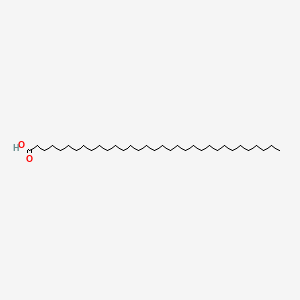| MeSH term | MeSH ID | Detail |
|---|---|---|
| Diabetes Mellitus, Type 2 | D003924 | 87 associated lipids |
| Hypercholesterolemia | D006937 | 91 associated lipids |
| Body Weight | D001835 | 333 associated lipids |
tritriacontanoic acid
tritriacontanoic acid is a lipid of Fatty Acyls (FA) class. Tritriacontanoic acid is associated with abnormalities such as hypercholesterolemia, Metabolic syndrome, Diabetes Mellitus, Non-Insulin-Dependent, Diabetes Mellitus, Insulin-Dependent and Parkinson Disease. The involved functions are known as Fermentation, Process, Longterm Effects, Pressure- physical agent and Lipid Metabolism. Tritriacontanoic acid often locates in Blood, Tissue fiber and A Fibers. The associated genes with tritriacontanoic acid are STN gene. The related lipids are Total cholesterol and blood lipid.
Cross Reference
Introduction
To understand associated biological information of tritriacontanoic acid, we collected biological information of abnormalities, associated pathways, cellular/molecular locations, biological functions, related genes/proteins, lipids and common seen animal/experimental models with organized paragraphs from literatures.
What diseases are associated with tritriacontanoic acid?
tritriacontanoic acid is suspected in hypercholesterolemia, Metabolic syndrome, Diabetes Mellitus, Non-Insulin-Dependent, Diabetes Mellitus, Insulin-Dependent, Parkinson Disease and other diseases in descending order of the highest number of associated sentences.
Related references are mostly published in these journals:
| Disease | Cross reference | Weighted score | Related literature |
|---|
Possible diseases from mapped MeSH terms on references
We collected disease MeSH terms mapped to the references associated with tritriacontanoic acid
PubChem Associated disorders and diseases
What pathways are associated with tritriacontanoic acid
There are no associated biomedical information in the current reference collection.
PubChem Biomolecular Interactions and Pathways
Link to PubChem Biomolecular Interactions and PathwaysWhat cellular locations are associated with tritriacontanoic acid?
Visualization in cellular structure
Associated locations are in red color. Not associated locations are in black.
Related references are published most in these journals:
| Location | Cross reference | Weighted score | Related literatures |
|---|
What functions are associated with tritriacontanoic acid?
Related references are published most in these journals:
| Function | Cross reference | Weighted score | Related literatures |
|---|
What lipids are associated with tritriacontanoic acid?
Related references are published most in these journals:
| Lipid concept | Cross reference | Weighted score | Related literatures |
|---|
What genes are associated with tritriacontanoic acid?
Related references are published most in these journals:
| Gene | Cross reference | Weighted score | Related literatures |
|---|
What common seen animal models are associated with tritriacontanoic acid?
There are no associated biomedical information in the current reference collection.
NCBI Entrez Crosslinks
All references with tritriacontanoic acid
Download all related citations| Authors | Title | Published | Journal | PubMed Link |
|---|---|---|---|---|
| Sierra M et al. | Therapeutic effects of psyllium in type 2 diabetic patients. | 2002 | Eur J Clin Nutr | pmid:12209371 |
| Marlett JA and Fischer MH | A poorly fermented gel from psyllium seed husk increases excreta moisture and bile acid excretion in rats. | 2002 | J. Nutr. | pmid:12221223 |
| Romero AL et al. | The seeds from Plantago ovata lower plasma lipids by altering hepatic and bile acid metabolism in guinea pigs. | 2002 | J. Nutr. | pmid:12042433 |
| Plantago ovata. (Psyllium). | 2002 | Altern Med Rev | pmid:11991795 | |
| Jenkins DJ et al. | Soluble fiber intake at a dose approved by the US Food and Drug Administration for a claim of health benefits: serum lipid risk factors for cardiovascular disease assessed in a randomized controlled crossover trial. | 2002 | Am. J. Clin. Nutr. | pmid:11976156 |
| Bhatnagar D | Should pediatric patients with hyperlipidemia receive drug therapy? | 2002 | Paediatr Drugs | pmid:11960511 |
| Vega-López S et al. | Sex and hormonal status influence the effects of psyllium on lipoprotein remodeling and composition. | 2002 | Metab. Clin. Exp. | pmid:11912561 |
| Kris-Etherton PM et al. | High-soluble-fiber foods in conjunction with a telephone-based, personalized behavior change support service result in favorable changes in lipids and lifestyles after 7 weeks. | 2002 | J Am Diet Assoc | pmid:11985406 |
| Neiffer DL | Clostridium perfringens enterotoxicosis in two Amur leopards (Panthera pardus orientalis). | 2001 | J. Zoo Wildl. Med. | pmid:12790411 |
| Wiesel PH et al. | Management of faecal incontinence and constipation in adults with central neurological diseases. | 2001 | Cochrane Database Syst Rev | pmid:11687140 |
